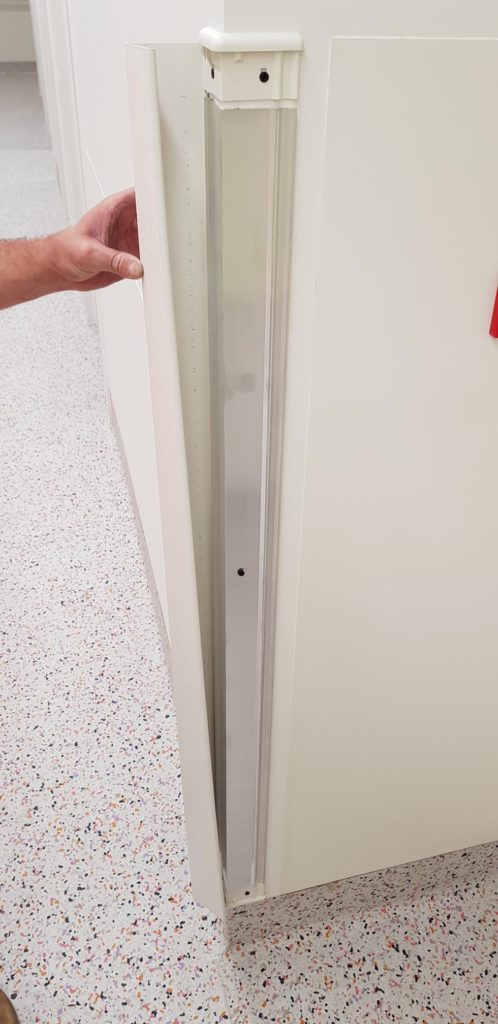
6 Cost-Cutting Shortcuts To Look Out for and Avoid – Door & Wall Protection
In the hyper-competitive construction world, where everything goes to ‘tender,’ and ‘Price’ is (apparently) everyone’s main concern, it is unsurprising that a lot of shortcuts get taken – Door & Wall Protection is no exception.
It is very difficult to specify something 100% these days, even in a performance specification, where shortcuts and substitutes abound, that on face value, appear to be legitimate or even make sense, but are nothing more than a quality compromise and cost-cutting exercise on the part of the supplier.
In this article, we will unpack a number of these ‘shortcuts’ to look out for and avoid where possible (by specifying them out from the get-go). I know it may seem strange that we as a supplier are laying our cards out on the table for all to see, but we visit hundreds of hospitals, aged cares, schools etc. each year and are tired of seeing product fail well before it should. We are doing our best to raise the standard, right across the industry.
Cliched I know, but how true – Bitterness of poor quality lasts long after the Sweetness of cheap price is forgotten. Price & quality doesn’t always mean the product in itself is cheap or poor quality, it could just be how it is installed.
- Crashrail – clips instead of continuous retainer:
One of the biggest cost savings a supplier can make is by reducing the amount of the material in an area where it is not seen. An example of this is supplying the aluminium retainer as narrow clips that are spaced every 500mm approximately on the wall, rather than a continuous aluminium retainer. Although there is no visual difference, the performance difference is significant.
Our team regularly does maintenance audits and measures at existing hospitals that are suffering from damage. When it comes to crashrail, more than any other defect we see is insufficent retainer behind the bumprail covers. This results in the product failing in between where it is supported or clipping off the aluminium brackets.
- Door Frame Protection – multiple piece instead of one-piece:
Find out more about the difference between One-Piece and Multiple Door Frame Protection
It is true that one-piece Door Frame Protection is difficult to make, compared to that made from multiple pieces, however it is essential that one-piece frame protection is used (yes, even if your frames are pressed metal). Although multiple piece frame protection does take longer to install, it can be a shortcut for most suppliers, due to the tricky manufacture process and the large number of custom door frame profiles.
It is no secret that door frames take a beating. That is why you install frame protection in the first place. The problem with taking the ‘multiple-piece’ shortcut is that the frame protection pieces will separate over time, causing a couple of major ongoing issues for the client.
- Infection control hazard: Areas of separation that are impossible to clean gather dust and become a breeding ground for bacteria
- Aesthetic issue: When the protection fails, it doesn’t look pretty. Most would prefer to look at a chipped steel frame
- Performance issue: Aside from looking bad and not being safe, it is no longer doing its job
- Door Frame Protection – one-piece, but missing final return:
This may seem minor, but when using one-piece frame protection, you don’t want any edges that can peel away from the frame when they are hit by a passing bed, trolley or person. To make this possible, frame protection need to have a final fold that returns back into the wall.
- Tape-On Corner Guards – folded not extruded:
There are two types of Tape-On Corner Guards – folded and extruded. Extrusion is where the corner guard comes out of a machine pre-formed to 90°, whereas a folded corner guard is manufactured from flat sheet material and folded to the desired angle. Although these may appear to be the same thing, folded corner guards are inherently weaker than extruded. We at Acculine make both folded and extruded, but we want to make sure that our clients know which one is suitable for their application. Folded is only a benefit for various angles other than 90 degrees, but shouldn’t be used in demanding hospital environments or other high traffic buildings.
- High-impact corner guards – insufficient fixings in the retainer:

Probably the most common feedback we hear from maintenance teams in hospitals is that the corner guards are getting ripped off the walls. This is largely due to insufficient fixings through the retainer, into the substrate. The image above is from a recently completed hospital project we were inspecting. We noticed that the corner guards seemed somewhat loose, so removed the cover to find that a 1200mm high corner guard had only 1 screw holding the aluminium retainer to the wall. The endcaps are much more secure than the corner guard itself, but unfortunately the 4 x screws into the endcaps are useless in holding the retainer to the wall. One way to mitigate this is to specify a corner guard where the endcaps overlap the retainer (as per below picture), rather than sit above. This way you will always be guaranteed of at least 4 screws per corner guard. Of course, the other way is to make sure you inspect the retainers before the covers are clipped on.

Below is a guide on how many screws are recommended based on the height of the corner guard.
| Corner Guard Height | No. of Screws |
|---|---|
| Up to 900mm | 6 |
| 900-1200mm | 8 |
| 1200-1500mm | 10 |
- Timber handrails – Budget grade timber rather than Select grade:
There are timber handrails and timber handrails – not all are created equal. You need to ensure that you are getting select grade quality timber for your handrails, not budget grade timber. It is important to note that some suppliers may use this term slightly differently, so you are best to request a product sample before approving the material. Although even select grade timber still has some knots and grain present, it is significantly less than budget grade timber.
******************************
Possible improvements
- Have example spec to download so architect can see how to specify these products and ensure they will be compliant.
- Revise spec sheets to snapshot the most important information i.e. compliance, shortcuts, best practices
